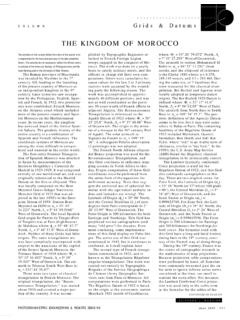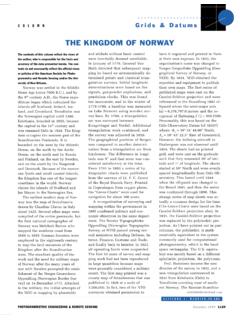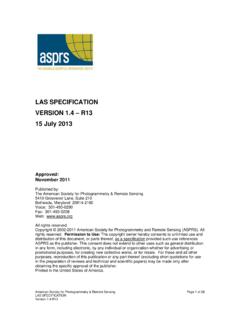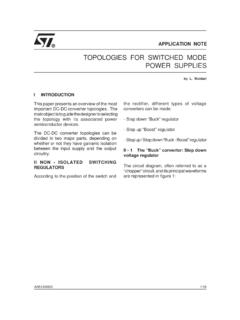Transcription of The LAS file format contains a header block, variable ...
1 LAS Specification Version Approved by ASPRS Board 09/02/2008 LAS 1 LAS format VERSION : This document reflects the second revision of the LAS format specification since its initial version release. Version retains the same structure as version including identical field alignment. LAS file Input/Output (I/O) libraries will require slight modifications in order to be compliant with this revision. A LAS Reader will read LAS (without the new enhancements) with no modifications. A detailed change document that provides both an overview of the changes in the specification as well as the motivation behind each change is available from the ASPRS website in the LIDAR committee section.
2 The additions of LAS include: GPS Absolute Time (as well as GPS Week Time) LAS and LAS specified GPS Week Time only. This meant that GPS time stamps rolled over at midnight on Saturday. This makes processing of LIDAR flight lines that span the time reset difficult. LAS allows both GPS Week Time and Absolute GPS Time (POSIX) stamps to be used. Support for ancillary image data on a per point basis. You can now specify Red, Green, Blue image data on a point by point basis. This is encapsulated in two new point record types (type 2 and type 3).
3 LAS format DEFINITION: The LAS file is intended to contain LIDAR point data records. The data will generally be put into this format from software ( provided by LIDAR hardware vendors) which combines GPS, IMU, and laser pulse range data to produce X, Y, and Z point data. The intention of the data format is to provide an open format that allows different LIDAR hardware and software tools to output data in a common format . The format contains binary data consisting of a header block, variable Length Records, and point data. PUBLIC header BLOCK variable LENGTH RECORDS POINT DATA RECORDS All data is in little-endian format .
4 The header block consists of a public block followed by variable Length Records. The public block contains generic data such as point numbers and coordinate bounds. The variable Length Records contain variable types of data including projection information, metadata, and user application data. DATA TYPES: The following data types are used in the LAS format definition. char (1 byte) unsigned char (1 byte) short (2 bytes) unsigned short (2 bytes) LAS 2 long (4 bytes) unsigned long (4 bytes) double (8 byte IEEE floating point format ) PUBLIC header BLOCK.
5 Item format Size RequiredFile Signature ( LASF ) char[4] 4 bytes * File Source ID unsigned short 2 bytes * Global Encoding unsigned short 2 bytes * Project ID - GUID data 1 unsigned long 4 bytes Project ID - GUID data 2 unsigned short 2 byte Project ID - GUID data 3 unsigned short 2 byte Project ID - GUID data 4 unsigned char[8] 8 bytes Version Major unsigned char 1 byte * Version Minor unsigned char 1 byte * System Identifier char[32] 32 bytes * Generating Software char[32]
6 32 bytes * File Creation Day of Year unsigned short 2 bytes File Creation Year unsigned short 2 bytes header Size unsigned short 2 bytes * Offset to point data unsigned long 4 bytes * Number of variable Length Records unsigned long 4 bytes * Point Data format ID (0-99 for spec) unsigned char 1 byte * Point Data Record Length unsigned short 2 bytes * Number of point records unsigned long 4 bytes * Number of points by return unsigned long[5] 20 bytes * X scale factor double 8 bytes * Y scale factor double 8 bytes * Z scale factor double 8 bytes * X offset double 8 bytes * Y offset double 8 bytes * Z offset double 8 bytes * Max X double 8 bytes * Min X double 8 bytes * Max Y double 8 bytes * Min Y double 8 bytes * Max Z double 8 bytes * Min Z double 8 bytes * Any field in the Public header Block that is not required and is not used must be zero filled.
7 File Signature: The file signature must contain the four characters LASF , and it is required by the LAS specification. These four characters can be checked by user software as a quick look initial determination of file type. File Source ID (Flight Line Number if this file was derived from an original flight line): This field should be set to a value between 1 and 65,535, inclusive. A value of zero (0) is interpreted to mean that an ID has not been assigned. In this case, processing software is free to assign any LAS 3valid number. Note that this scheme allows a LIDAR project to contain up to 65,535 unique sources.
8 A source can be considered an original flight line or it can be the result of merge and/or extract operations. Global Encoding: This is a bit field used to indicate certain global properties about the file. In LAS (the version in which this field was introduced), only the low bit is defined (this is the bit, that if set, would have the unsigned integer yield a value of 1). This bit field is defined as: Global Encoding - Bit Field Encoding Bits Field Name Description0 GPS Time Type The meaning of GPS Time in the Point Records 0 (not set) -> GPS time in the point record fields is GPS Week Time (the same as previous versions of LAS) 1 (set) -> GPS Time is standard GPS Time (satellite GPS Time) minus 1 x 109.
9 The offset moves the time back to near zero to improve floating point resolution. 1:15 Reserved Must be set to zero Note that in the previous version of LAS (LAS ), this was a reserved field that had to be set to zero. Thus LAS files that use GPS Week Time and point record types 0 and 1 (the only types supported in previous versions of LAS) will be identical to LAS files with the exception of the minor version number. Project ID (GUID data): The four fields that comprise a complete Globally Unique Identifier (GUID) are now reserved for use as a Project Identifier (Project ID).
10 The field remains optional. The time of assignment of the Project ID is at the discretion of processing software. The Project ID should be the same for all files that are associated with a unique project. By assigning a Project ID and using a File Source ID (defined above) every file within a project and every point within a file can be uniquely identified, globally. Version Number: The version number consists of a major and minor field. The major and minor fields combine to form the number that indicates the format number of the current specification itself.
















